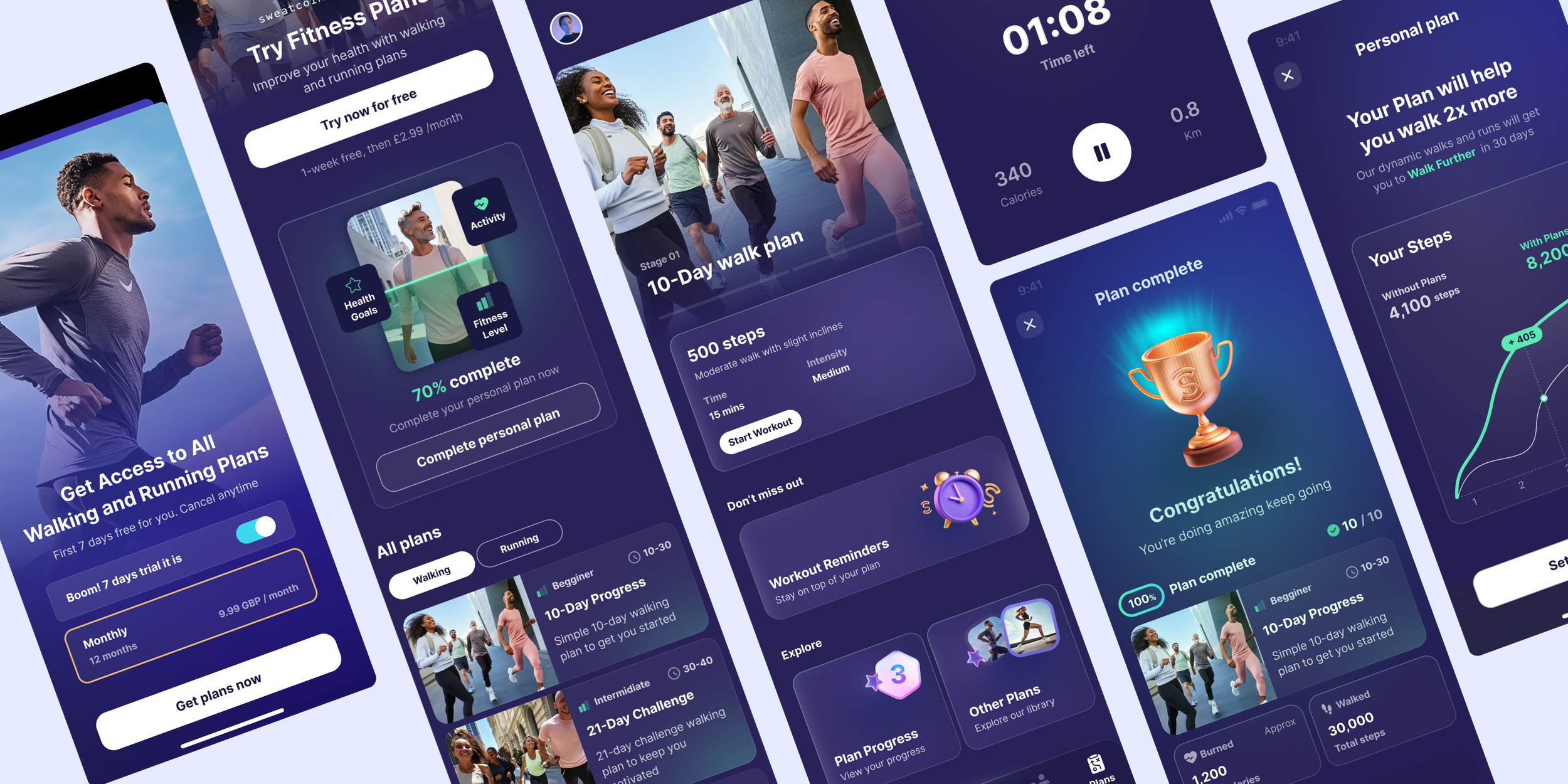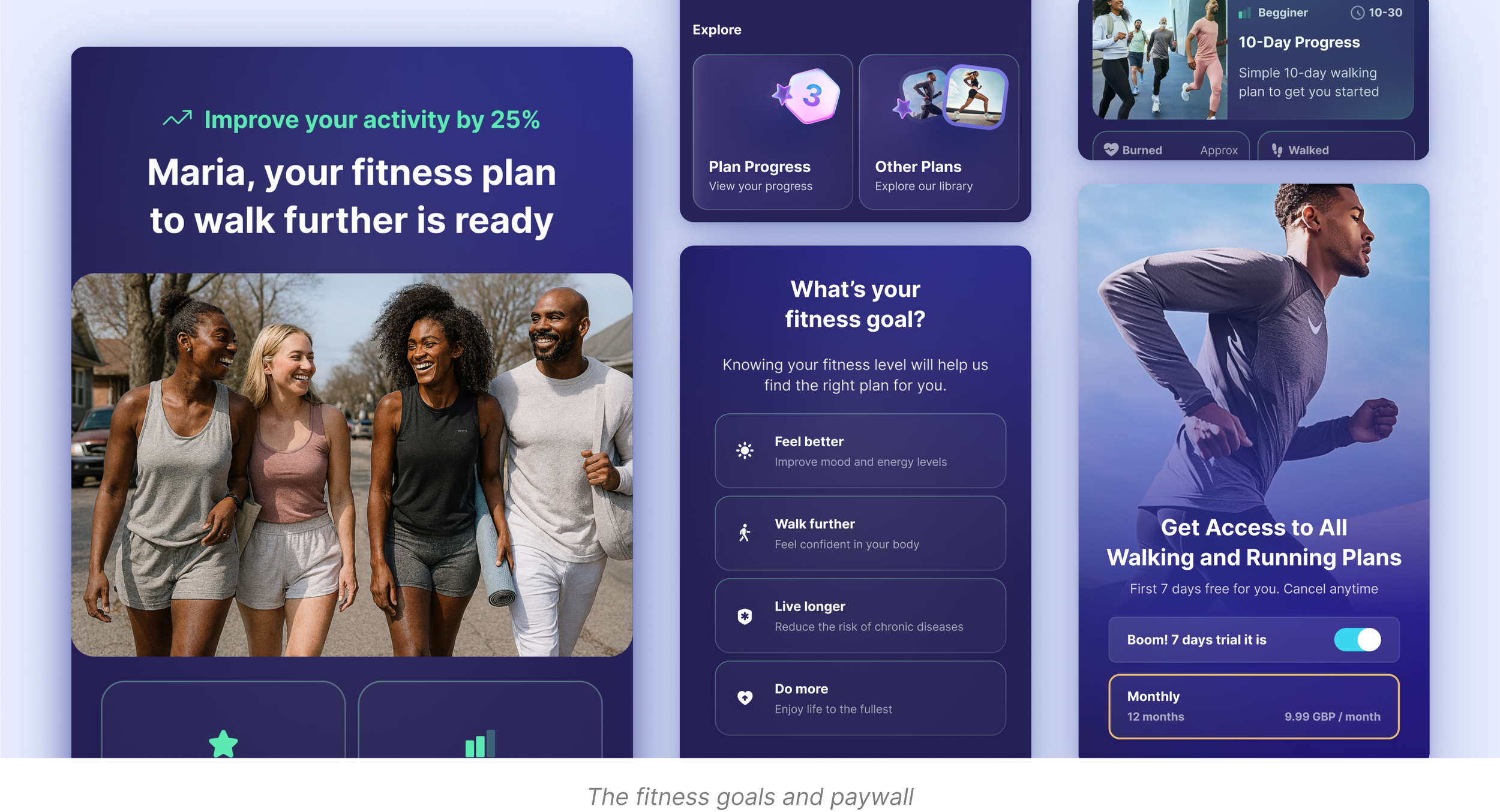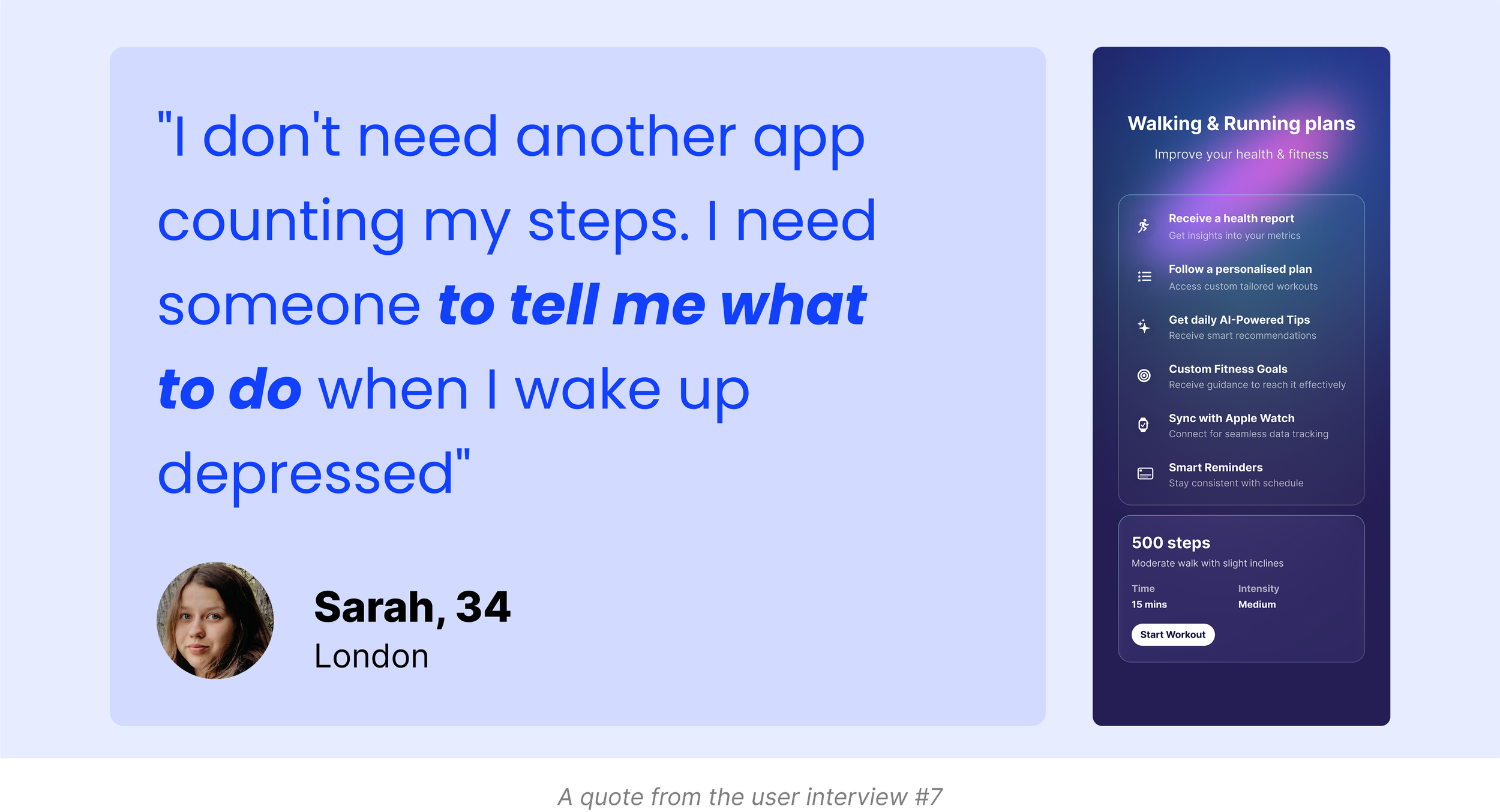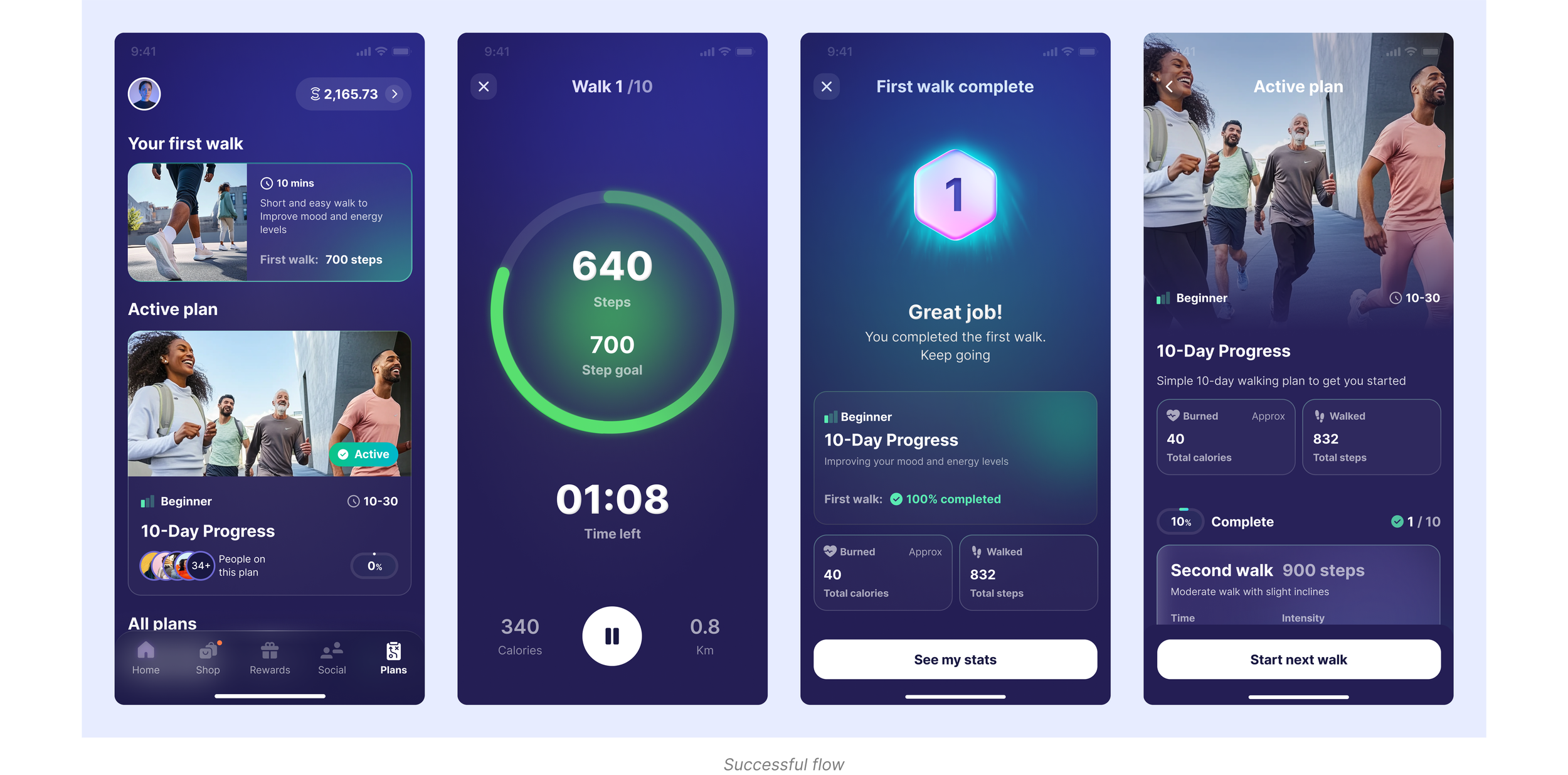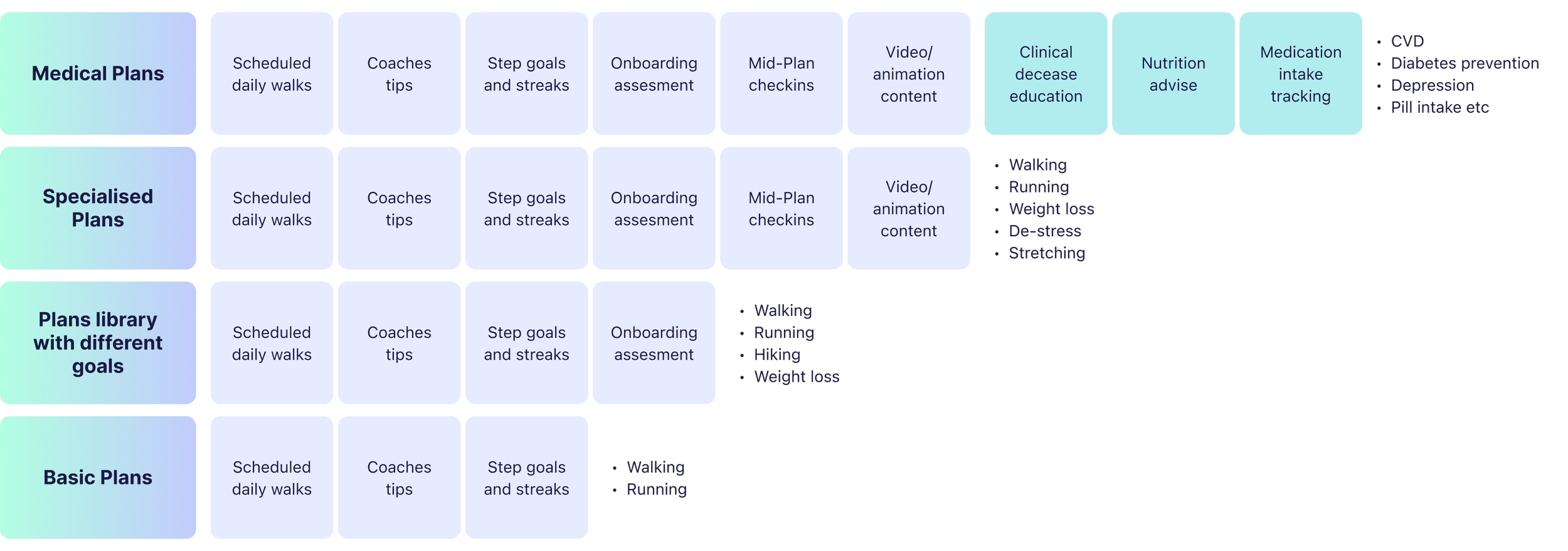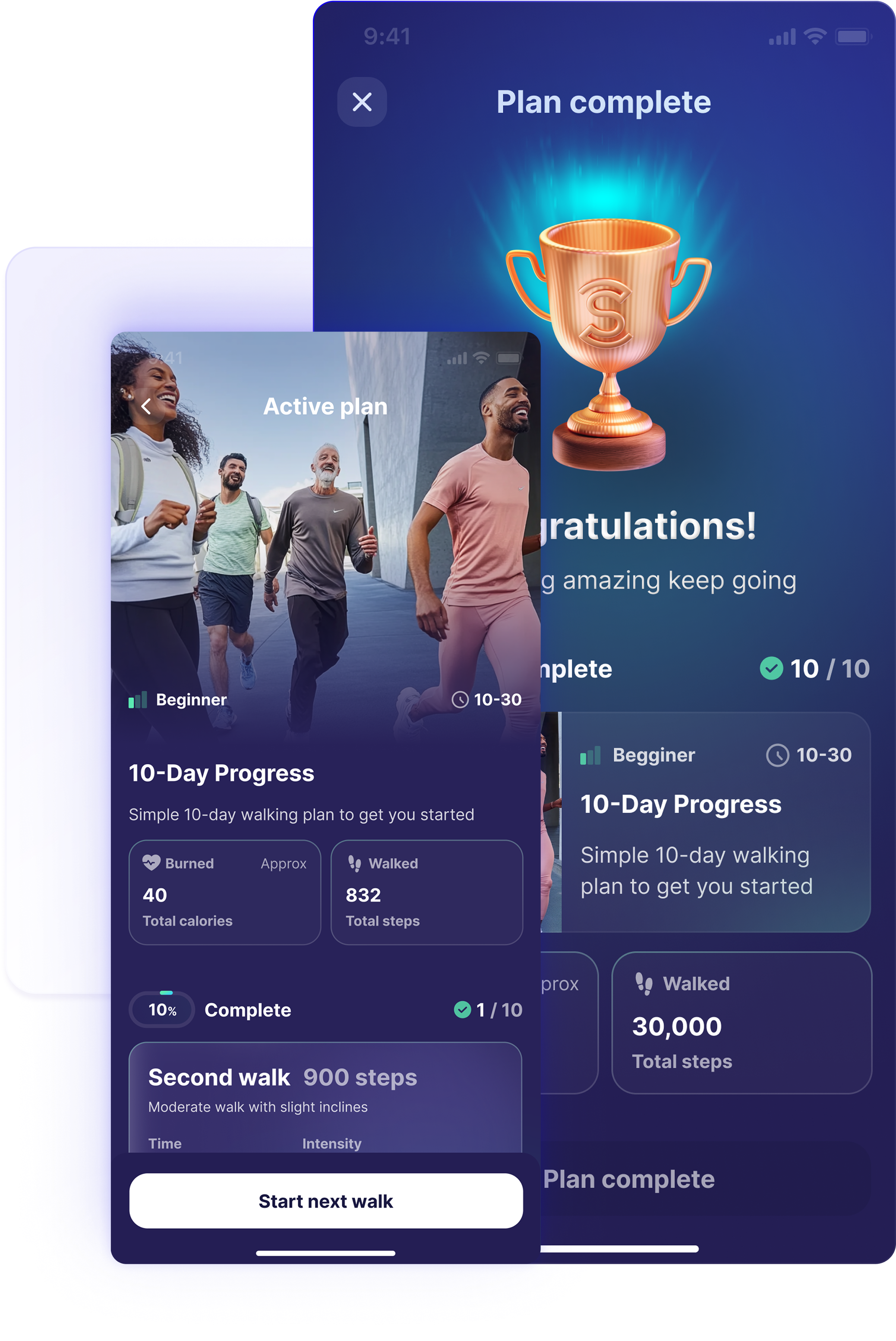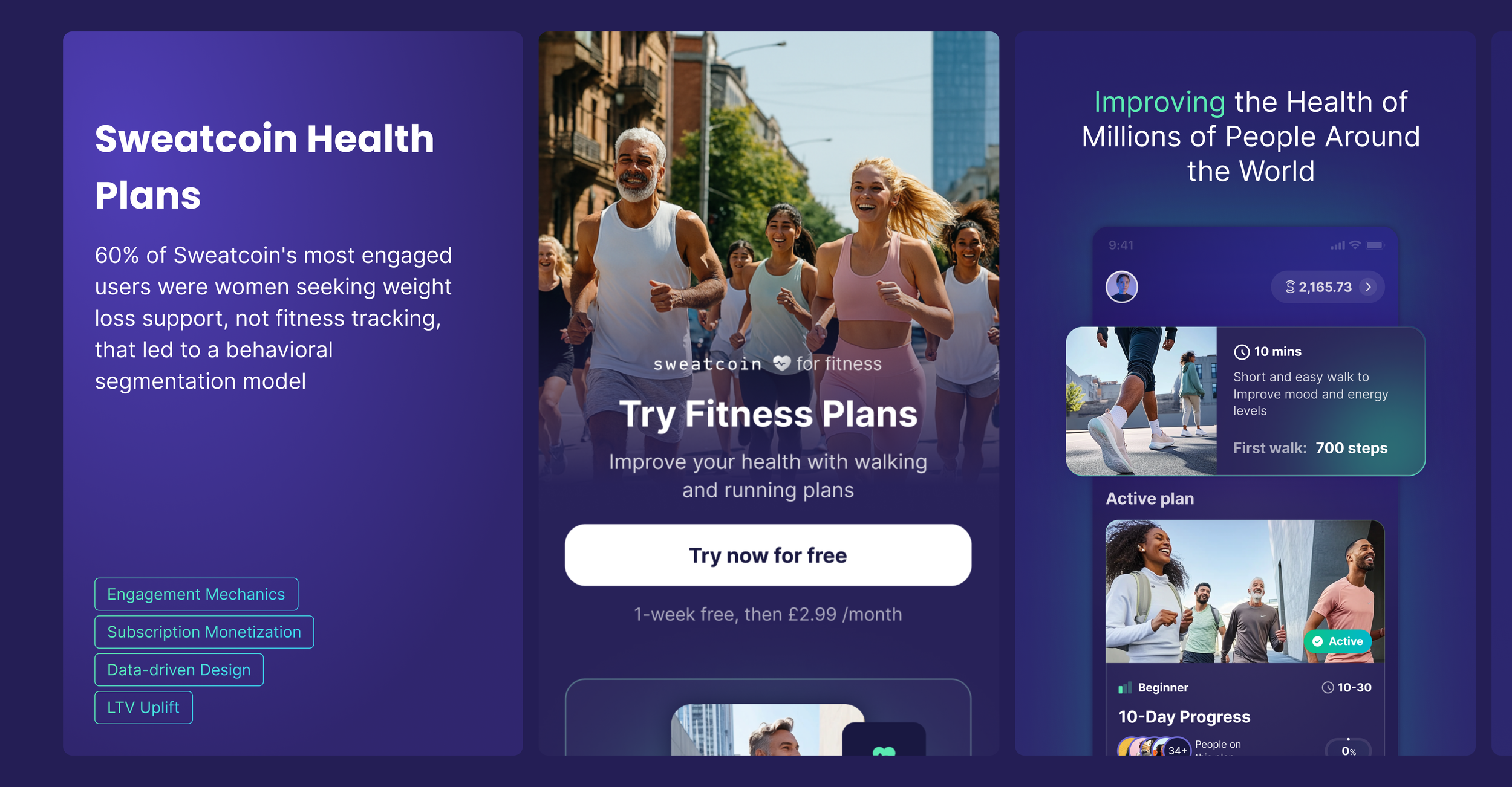Sweatcoin Health Plans:
How We Discovered an $8M Hiding Opportunity
Sweatcoin is a Health & Fitness app that turns steps into currency, using rewards and gamification to drive user activity and retention with 150M+ users
Details
Project link
Check in App Store
Industry
Health & Fitness / B2C
Role
Design Director
The $8 Million Surprise
With 150M+ users globally, our step-tracking app had massive reach, but our premium conversion skewed heavily toward already-active users, missing our largest engaged segment entirely.
The research revealed a stark misalignment:
60% of 456K Health Plans viewers were women seeking weight loss (35%) and mental wellness (21%) support
Our product is optimized for the 14% highly active users (9,000+ steps)
25% of engaged users were low-activity (<3,000 steps), predominantly women
Result: <2% conversion rate for our majority user base vs 14-48% for fitness-focused features
This wasn't just a feature gap. It was a fundamental product-market misalignment representing $8-12M in untapped annual recurring revenue.
Executive Summary
| Role | Design Director |
| Team | 3 direct reports (UX Researcher, Product Designers), cross-functional squad of 8 |
| Timeline | 6 months (left pre-launch) |
| Business Impact | Identified $8–12M ARR opportunity through behavioral segmentation of 150M users, transforming company-wide product strategy |
| Research Scale | 456K+ users engaged, 5.4K surveys completed, $200K investment with 40x ROI |
| Key Decisions | Simplified onboarding (89% completion), chose accessibility over innovation (80% task completion), prioritized by revenue per engineering hour |
"The women aren't here for fitness. They want to lose weight. They want to feel better. And we're giving them marathon training plans"
Our fake door test revealed the mismatch
The kicker: users clicking Health Plans were 3x more likely to pay for premium features. We'd accidentally discovered our highest-value segment, and we were completely ignoring them.
456,548 users saw our Health Plans teaser
42,366 clicked (9.2% CTR)
5,382 completed surveys telling us exactly what we were missing
Current state: 2% conversion on 150M users = $3M ARR
Opportunity: 5% conversion on targeted 60% = $12M ARR
Investment needed: $200K research + 6-month team
ROI: 20x in year one
The Business Case That Changed Minds
Leadership Approach
Design leadership isn't about having answers. It's about asking better questions
As Design Director, I reframed this from a feature request ("add health plans") to a strategic initiative worth 5-8% of company revenue:
Created a shared language: Our behavioral segmentation model gave everyone the same vocabulary
Set principles over features: We agreed on outcomes before debating solutions
Tied every decision to revenue: Showed that 1% conversion improvement = $1.5M ARR
Leading Through Ambiguity
Built cross-functional alignment
Led a team of 2 designers and 1 researcher within an 8-person squad
Guided designer's growth from UI execution to systems thinking (already on team)
Aligned competing priorities across Product, Data, and Engineering teams
Navigated organizational complexity
The product wanted speed. Data wanted proof. Engineering pushed back on flexibility.
Created alignment through behavioral segmentation model based on 5,382 survey completions
Defended critical scope decisions: kept personalization and progress visibility despite 30% engineering pushback
Managed $200K research budget across fake door tests, surveys, and user interviews
Set strategic direction through design principles
Outcome over output — Show health impact, not just step counts
Progress over performance — Reward consistency for inactive users
Flexibility within structure — Guided paths that adapt to real life
The Research That Changed Our Thinking
That quote from user interview #7 changed everything. We weren't building a fitness feature. We were building a behavioural support system.
What 5,382 Surveys Taught Us
Our "low activity" users (25% of base) were 67% women, taking <3,000 steps daily, with weight loss as primary goal. They had money to spend but nothing to buy.
| Segment | Size | Profile | Opportunity |
|---|---|---|---|
| Dormant | 37.5M (25%) | 67% women, <3k steps | Highest churn risk, untapped premium potential |
| Emerging | 67.5M (45%) | Mixed gender, 3–7k steps | Sweet spot for behavioral change |
| Active | 45M (30%) | Current premium base | Already monetized |
But here's what shocked us: the Dormant segment showed 3x higher engagement with reward features when they clicked Health Plans:
Daily Bonus participation: 48% (vs 14% baseline)
Super Draw purchases: 33% (vs 16% baseline)
Key Strategic Decisions
Research-Driven Pivot (Saved 3 months, $500K)
Decision: Killed our initial “performance plans” direction after fake door test (456K views → 42K clicks → 5.4K survey completions) showed 90% interest from inactive users
Impact: Avoided building for wrong audience, redirected to $8–12M opportunity
Tiered Architecture Framework
Decision: Designed modular plan system (Basic/Goal-Based/Specialized/Medical) vs. monolithic features
Structure: 10–45 day programs with daily goals, AI coaching tips, progress tracking
Example: “10-Day Starter Plan” – 132–468 cal burn, 10–30 min daily, beginner level
Value:
- Enabled 70% faster content updates post-launch
- Architecture adopted by Rewards and Challenges teams (impacting 40M+ MAU)
- Reduced engineering complexity by 40%
- Created foundation for 50+ plan variations without code changes
- Integrated with existing gamification (streaks, milestones) for 3x better retention
Behavioral Segmentation Model
Introduced company’s data-driven behavioral model based on 150M user base:
- Dormant (0–3k steps): 37.5M users (25%), highest churn risk, 67% women
- Emerging (3–7k steps): 67.5M users (45%), highest revenue potential
- Active (7k+ steps): 45M users (30%), current premium base
Youth Market Discovery
Finding: 20% of Health Plans interest came from users under 18
Value: Identified 30M+ underserved young users
Impact: Sparked new work stream for youth wellness features
These models now drive:
- Growth team’s $15M acquisition budget allocation
- Product roadmap prioritisation (Q1–Q2 2024)
- Marketing segmentation (3x improved CAC)
Building the Solution
The Critical Design Decisions
Not all design decisions happen in Figma. Here are the calls I made:
Simplicity Over Sophistication
We had built an AI-powered adaptive system that adjusted daily goals based on performance.
- Why? Our low-activity users needed confidence, not complexity
- The trade-off: Less "innovative" but more accessible
- Result: 80% task completion vs 35% in user testing
Free Value Before Premium Push
Against strong sales objections, basic plans are completely free.
- Why? Trust before transaction for vulnerable users (remember: 67% were women seeking weight loss support)
- The trade-off: Delayed monetization for higher LTV
- Result: 2.5x higher premium conversion after 14 days vs immediate paywall
One Persona, Not Five
Focused the entire MVP on "Emerging Emma" — our 45% segment. Ignored power users entirely.
- Why? Better to delight 67M users than dilute for 150M
- The trade-off: Built for not our most vocal (active) users
- Result: 48% engagement from target segment vs 14% baseline
The Onboarding Revolution
Reduced our onboarding from 8 screens to 1 question: "What’s your main goal?"
- Why? 65% drop-off rate was killing us before users even started
- The trade-off: Less data collection upfront
- Result: 89% completion rate, 3x higher Day-1 retention
The Framework
Each tier could support 50+ variations without engineering changes. The Rewards team adopted it within weeks and followed the behavioral framework.

Organizational Impact
Although Health Plans were deprioritized in Q4 2024 for other revenue initiatives, the strategic work transformed how Sweatcoin approaches product development:
Before my involvement
Features built on assumptions about "average" users
Design engaged post-requirements
No systematic approach to behavioral change
After
Behavioral segments drive all feature prioritization
Research partnership model adopted across 3 teams
Design principles framework used in 2024 planning
Specific wins
CPO referenced our tiered UX approach in the company all-hands
Research cadence I established became the org standard
PM team adopted our user segmentation for Q1 roadmap company
Research & Development Investment
The Health Plans initiative represented one of Sweatcoin's largest research investments:
Research Scale
456,548 users exposed to fake door test
5,382 completed surveys (multi-stage screening)
48,189 total survey interactions
20+ user interviews across 6 countries
3-month longitudinal behavior analysis
Team Resources
8-person dedicated squad for 6 months
$200K research budget
Cross-functional workshops with 25+ stakeholders
This investment validated the strategic importance and helped secure behavioral transformation approach.
Projected Business Outcomes
Working with finance and data teams, we established success metrics based on industry benchmarks and our user research:
| Metric | Industry Benchmark | Our Target | Revenue Impact |
|---|---|---|---|
| Premium Conversion | 12% (top health apps) | +5–10% lift from 2% base | $8–12M ARR |
| Trial-to-Paid | 30% (7-day free trial) | 35% target | £9.99/month LTV |
| Daily Active Users | +10–20% (with coaching) | +15% increase (7.5M users) | $3M ad revenue |
| 30-day Retention | 3–8% average | 10%+ target | Reduced CAC by 25% |
| Feature Engagement | 14% (challenges) | 48% (health plans users) | 3.4x reward spend |
Key insights
This correlation proved Health Plans users were our highest-value segment across all monetization vectors.
Users clicking Health Plans showed 2-3x higher engagement with reward features:
Daily Bonus: 48% participation (vs 14% baseline)
Daily Draw: 55% participation (vs 25% baseline)
Super Draw purchases: 33% (vs 16% baseline)
Team Development Impact
Beyond product outcomes, I focused on building lasting design capability
Researcher growth: Led first major initiative → invited to company strategy committee → promoted to Senior Researcher
Designer evolution: Shifted from "UI creator" to "systems thinker" → promoted 6 months later
Team efficiency: Streamlined design sprints, reducing concept-to-prototype from 3 weeks to 11 days
Research democratization: Created playbook now used by 4 other teams
Impact highlits
Users engaged
456K+
Opportunityy
$8-12M
Engagement
48%
What This Taught Me About Design Leadership
Looking back, Health Plans wasn't about the feature. It was about transformation.
The Real Job of a Design Director
See the bigger picture — We found $8M hiding in demographic data
Build the conditions for success — Systems over solutions
Develop people while delivering — The team's growth outlasted the project
Navigate politics with principles — Data ends more arguments than opinions
The Real Job of a Design Director
I'd push harder for a limited beta. Even 1,000 users on Health Plans would have proven the revenue model. Sometimes, perfect is the enemy of good enough.
I don't know if Health Plans will succeed when it launches. But I do know the company now asks different questions. Who are we really building for? What do they actually need? That shift in thinking — that's what matters.
Design Director / Sweatcoin


